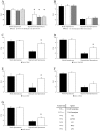Effects of 5-hydroxytryptamine on spermatozoal hyperactivation and in vitro fertilization in mice
- PMID: 31694987
- PMCID: PMC6923157
- DOI: 10.1262/jrd.2019-082
Effects of 5-hydroxytryptamine on spermatozoal hyperactivation and in vitro fertilization in mice
Abstract
In this study, we examined the effects of 5-hydroxytryptamine (5-HT) on the motility and hyperactivation of mouse spermatozoa. In addition, we examined whether 5-HT increases the success of in vitro fertilization (IVF) in mice. Interestingly, 5-HT and agonists of the 5-HT2, 5-HT3, 5-HT4, and 5-HT7 receptors significantly increased the percentage of hyperactivated spermatozoa but did not affect the percentage of motile spermatozoa. Moreover, agonists of the 5-HT2, 5-HT3, and 5-HT4 receptors significantly affected the velocities, linearity, straightness, wobbler coefficient, amplitude and/or frequency of spermatozoa. In particular, the improvement of hyperactivation by 5-HT was strongly inhibited by antagonists of the receptors 5-HT4 and 5-HT7 and was completely inhibited by a mixture of the four 5-HT-receptor antagonists. The increase in hyperactivation by the agonists was significantly inhibited by the corresponding 5-HT-receptor antagonist. Moreover, 5-HT significantly increased the percentage of two-cell embryos. The increase in the IVF success rate by 5-HT was significantly inhibited by a 5-HT4-receptor antagonist. These results suggest that 5-HT increased hyperactivation through the 5-HT receptors and increased the success of IVF in mice.
Keywords: 5-Hydroxytryptamine (5-HT); Hyperactivation; In vitro fertilization (IVF); Spermatozoa.
Conflict of interest statement
The authors declare that there are no conflicts of interest that could be perceived as prejudicing the impartiality of the research reported.
Figures



Similar articles
-
Progesterone increases the success of in vitro fertilization via enhanced sperm hyperactivation in mice.J Reprod Dev. 2023 Jun 6;69(3):147-153. doi: 10.1262/jrd.2022-114. Epub 2023 Mar 18. J Reprod Dev. 2023. PMID: 36935121 Free PMC article.
-
Influences of 5-hydroxytriptamine on sperm hyperactivation and in vitro fertility in rats.J Reprod Dev. 2025 Apr 14;71(2):85-92. doi: 10.1262/jrd.2024-078. Epub 2025 Jan 25. J Reprod Dev. 2025. PMID: 39864845 Free PMC article.
-
Serotonin-enhanced hyperactivation of hamster sperm.Reproduction. 2011 Aug;142(2):255-66. doi: 10.1530/REP-11-0074. Epub 2011 May 9. Reproduction. 2011. PMID: 21555358
-
Non-genomic regulation and disruption of spermatozoal in vitro hyperactivation by oviductal hormones.J Physiol Sci. 2016 May;66(3):207-12. doi: 10.1007/s12576-015-0419-y. Epub 2015 Nov 5. J Physiol Sci. 2016. PMID: 26541156 Free PMC article. Review.
-
Stimulation of sperm fertility in vitro by exogenous molecules.Reproduccion. 1981 Jul-Sep;5(3):169-76. Reproduccion. 1981. PMID: 7026315 Review. No abstract available.
Cited by
-
Progesterone increases the success of in vitro fertilization via enhanced sperm hyperactivation in mice.J Reprod Dev. 2023 Jun 6;69(3):147-153. doi: 10.1262/jrd.2022-114. Epub 2023 Mar 18. J Reprod Dev. 2023. PMID: 36935121 Free PMC article.
-
Enhancement of rat spermatozoal hyperactivation by progesterone.J Reprod Dev. 2023 Oct 20;69(5):279-290. doi: 10.1262/jrd.2023-040. Epub 2023 Sep 10. J Reprod Dev. 2023. PMID: 37690839 Free PMC article.
-
Serotonergic signals enhanced hamster sperm hyperactivation.J Reprod Dev. 2021 Aug 27;67(4):241-250. doi: 10.1262/jrd.2020-108. Epub 2021 May 12. J Reprod Dev. 2021. PMID: 33980767 Free PMC article.
-
Vasopressin V1a receptor and oxytocin receptor regulate murine sperm motility differently.Life Sci Alliance. 2023 Jan 17;6(4):e202201488. doi: 10.26508/lsa.202201488. Print 2023 Apr. Life Sci Alliance. 2023. PMID: 36650057 Free PMC article.
-
Possible Role of 5-Hydroxytryptamine (5-HT) Receptor on Human Sperm Motility Regulation.Cureus. 2023 Nov 27;15(11):e49530. doi: 10.7759/cureus.49530. eCollection 2023 Nov. Cureus. 2023. PMID: 38033435 Free PMC article.
References
-
- Yanagimachi R. Mammalian fertilization. In: Knobil E, Neill JD (ed.), The Physiology of Reproduction Vol. 2, 2nd ed. New York: Raven Press; 1994: 189–317.
-
- Suarez SS, Ho HC. Hyperactivated motility in sperm. Reprod Domest Anim 2003; 38: 119–124. - PubMed

